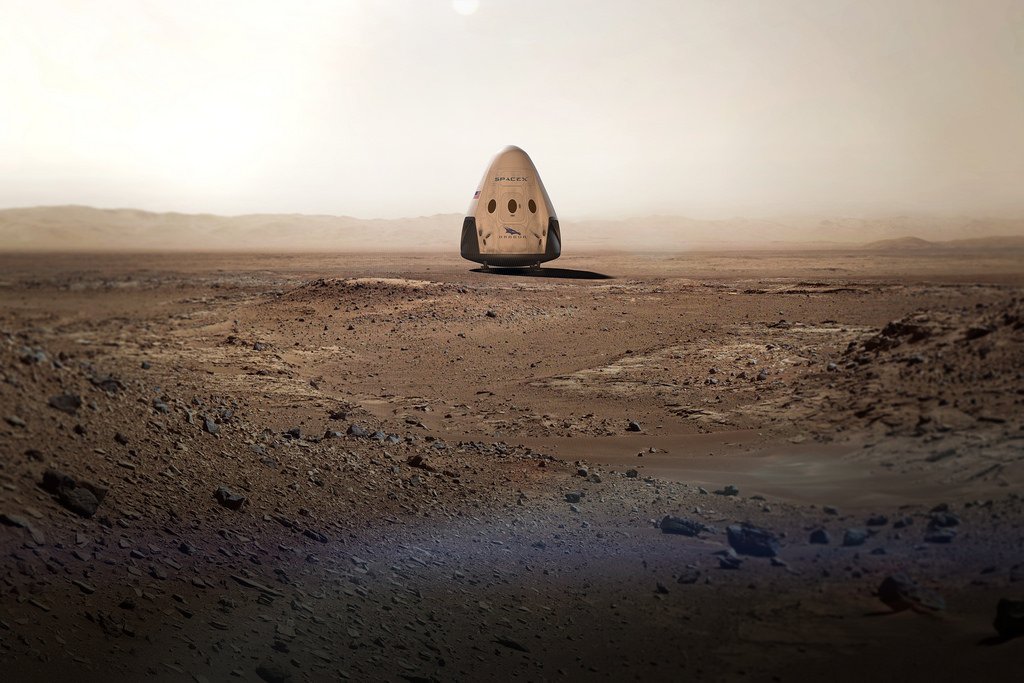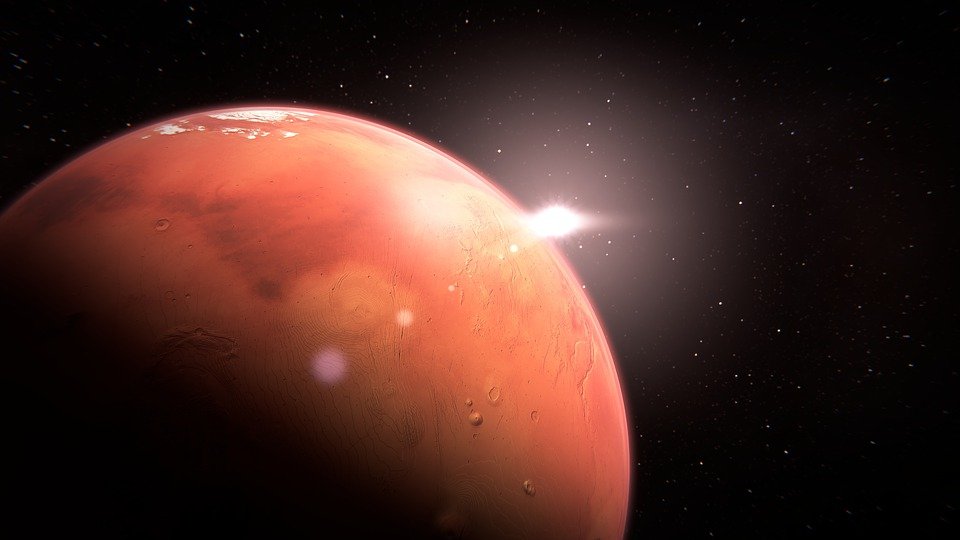 (Image from: flickr.com)
(Image from: flickr.com)
The space bubble had landed on a planet he had never seen before. The door opened and he got out. His suit was specially made to protect him from the hostile cosmic environment. He stepped foot on the planet. As far as the eye could see there were vast deserts of red sand and rock. Red was the color of the sky as well. Where was he? He didn't know, he didn't care, little difference did it make.
She was gone. Travelling through an asteroid zone together, her bubble was violently hit. A frozen asteroid the size of a monster truck fall onto her. He could still remember the bright explosion. The twist in his stomach. The air flow in his lungs cutting off. For hours he would keep travelling alone, setting mind and vehicle in auto pilot.
And then he reached this place. This huge, red, rocky desert. He picked some soil in his hand, it looked like rust. There must be lots of iron around here, he thought to himself. He needed to walk. Walking would always help him think clearly. He could slowly realise what had just happened and how his life turned upside down in an instant. Why did it have to be her? Why did he insist on taking this route when she had tried to put him off, Too dangerous, forget it! We're gonna damage the bubbles, her voice was still echoing in his ears. What an idiot! A stubborn idiot!
Walking he found a cliff. He stopped to look down. A crimson valley was expanding in front of him and the sun was about to set. He had never seen a most beautiful, blue sunset. The combination of the warm red shades in the scenery and the cold, blue sun created such a miraculous view. She would have loved it here. He squeezed his lips and looked up. Clouds had formed above his head. It must have been freezing cold 'cause snowflakes were coming down the skies. Snow? I did not see any lake or river all this time I've been wandering.
With slow moves he took his helmet off. He didn't seem to care about the toxic atmosphere. He wanted to feel the frozen snowflakes on his face. Aren't they like little, elaborate diamonds? that's what she had told him once. He laid down, his head was touching the ground, his eyes were closed and felt the cold snow melting on them, mixed with his tears. Then he took a deep breath and the smell of rust filled his lungs coming in all the way through his nostrils.
And suddenly he recalled that song she loved...
For the hopeless romantics, don't bother reading the science stuff below. If you do want to know where the inspiration came from, follow me to the next part.
As I was studying for my Trolls on Mars post, I was astonished by two things: the rust-covered surface of the planet and the blue sunset!
Why is Mars red?
Although Mars has almost the same composition as Earth (both being rocky with metallic cores), it has almost the double amount of iron oxide than Earth. Still we don't know where all this iron came from, but the hypothesis goes like this:
At the dawn of our solar system, iron was one of the elements in the initial dust and gas nebula. While the planets were forming, they were bombarded with asteroids and meteors that could have turned the newborn planets' surface into scorching pools of magma. On Earth, the amount of matter was greater than on Mars. Temperatures and pressure had possibly risen enough to change iron oxide into liquid iron that then reached our planet's still molten core. Mars, on the other hand, being smaller (meaning gravity forces were weaker here) and less dense, did not obtain as much material to evolve just like Earth, so it was left with iron oxide covering its mantle and a much smaller iron core.
Iron looks black, but Mars' ground looks brownish-red because there is plenty of iron oxide in it, rust to put it simply. How did all this iron rust is another question. Was it the rainfalls back in the times when there was liquid water on the planet? Was it the sunlight breaking down atmospheric components (like carbon dioxide) releasing oxidants (such as ozone and hydrogen peroxide)? Was it the Martian sandstorms that granulated the quartz crystals in the ground exposing their rich-in-oxygen interior? [1] - [2]
Another story says that the red tint of the planet does not come only from the iron oxides, but it's the result of mixing sand with magnetite (a mineral found in Martian basalt). As the sand is transported over the planet's surface, it is mixed with the magnetite and produces a fine red dust of hematite. [3]

(Image from: pixabay.com)
Sources: [1]nature.com - [2]space.com- [3] wired.com
Blue sunsets?
On Earth the sky appears blue because elements in the atmosphere scatter blue wavelength photons (Rayleigh scattering, watch the video for a short explanation). Oxygen and Nitrogen atoms can scatter short wavelengths, like blue and purple, leaving red, orange and yellow pass undisturbed through the atmosphere. Why we don't get the sky as a mix of violet and blue? Because our eyes are more sensitive to blue. The sun is rich in yellow light frequencies (lower frequencies/greater wavelengths) that's why it appears yellow to us. At sunset the sun reaches the horizon, meaning that the light has longer distance to cover before reaching our eyes. So the sunlight meets more atmospheric particles on its way that enhance certain wavelength scattering, guess what colors they are...red and orange.
On Mars, which has a different atmospheric composition (a lot thinner atmosphere, filled with fine dust particles), the opposite thing happens. The iron oxides in the planet's atmosphere absorb short wavelengths (blue and green) and scatter red photons, coloring the planet in warmer shades of red and orange. Dust particles in the sun's direction, when it approaches the horizon, scatter the blue wavelengths creating this weird, blue sunset.
Sources: [4] universetoday.com - [5] physicsclassroom.com
Bonus: Dry-ice snow on Mars
There might not be liquid water around Mars, but snow can fall on the planet. Well, not that it would cover the ground as it will normally sublime before getting anywhere near the surface. Water deposits on the Red Planet are not like Earth, they are mostly ice rich in CO2. At nights temperatures dramatically drop (from -73 °C around the equator to -125 °C at the poles). When sunlight hits, it allows for water to evaporate and form low-pressure clouds near the ground. As the night comes again, these clouds instantly crystalize into ice and then sudden bursts of precipitation happen. Some of these dry ice snowflakes might make it to the ground, but most of them will sublimate to gas forming streaks named virgae.
Sources: [6] iflscience.com - [7] spaceanswers.com

Thank you very much for being here! I appreciate your support. If you want to see more of my posts, check some of the links below:
- Bizarre Natural Phenomena Vol.37 - Cold And Dirty "Lava" (Mud Volcanoes)
- Trolls Around The Solar System - Part 3, Mars
- A Christmas Present For Alice - A Short Story Of Fantasy
- Bizarre Natural Phenomena Vol.36 - Diamonds In The Sky (Diamond Dust And Optical Illusions)
- Diamond Rain In The Forest - A Short Story Of Fantasy

Until my next post,
Steem on and keep smiling, people!




